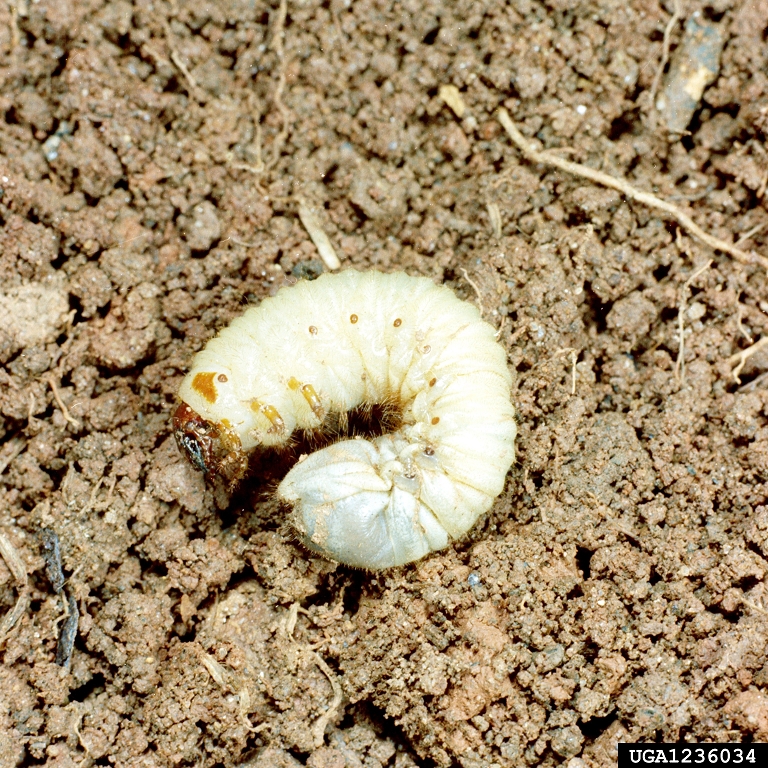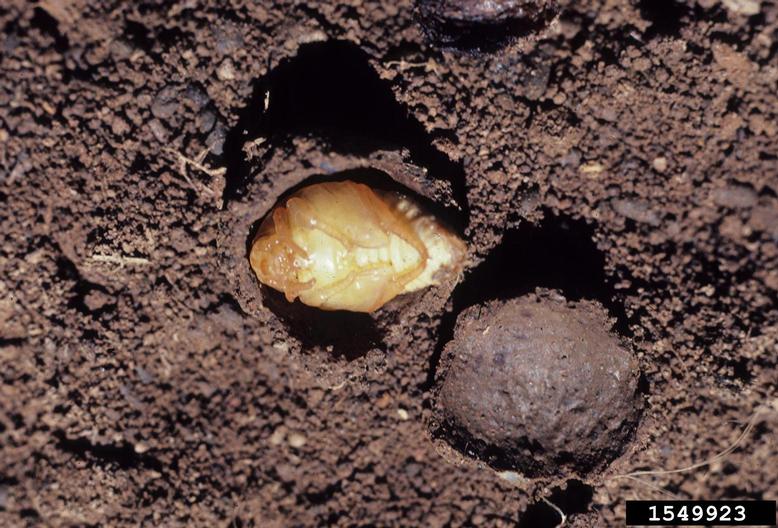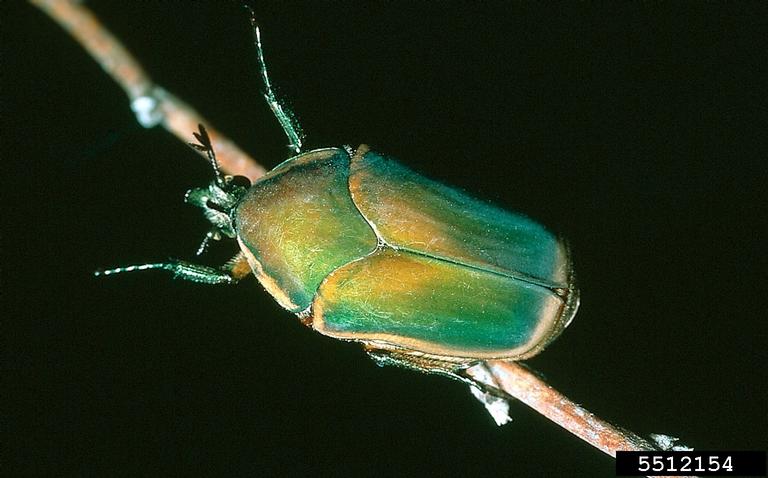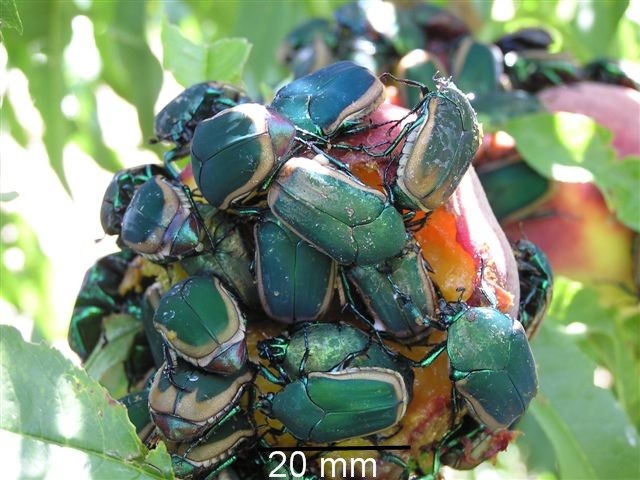 Managing Green Fruit Beetles - August 20, 2014 Jeff Schalau, Agent, Agriculture & Natural Resources University of Arizona Cooperative Extension, Yavapai County As our deciduous fruit crops ripen, birds and insects watch and wait for their chance to get their share too. Covering trees with netting can protect crops from birds, but the netting is not fine enough to exclude fruit-feeding insects. In the fruit growing areas of Arizona, green fruit beetles are a common pest of ripening fruit crops. When the crop to ripens, they often appear in such large numbers you can’t see the fruit for the beetles. This seasonal phenomenon is always challenging. The green fruit beetle (Cotinis mutabilis) is a large metallic beetle (1.25 inch long) with a scarab shape. The larval stage is a C-shaped, creamy white grub, which feeds on decaying organic material in the soil, such as piles of manure, partially decomposed compost, or piles of lawn clippings. Adult beetles emerge in summer and feed on soft, ripe fruit such as tomatoes, peaches, plums, figs, and apricots. When fruit is ripe, they literally cover it feeding in large groups. The grubs do not damage fruit. Photos of all life stages are included on the web version of this column (see URL below). Green fruit beetles have one generation each year. The grubs overwinter in the soil preferring piles of horse manure, compost piles, and soils with ample organic matter. They may become active during warm winter days. Grub activity increases as the spring weather becomes consistently warmer. In some cases, the large numbers of grubs can damage pastures and lawns creating large dead patches where roots have been eaten. The grubs pupate in the soil and emerge after 2-3 weeks as adult beetles. In some parts of the country, predatory wasps are known to prey on fruit beetle grubs. I am not sure if we have many insects that are natural enemies of fruit beetle grubs in Arizona, but I would suspect there are. Skunks will often dig for beetle grubs in lawns and compost piles. Even though this digging can cause cosmetic damage to the sod, skunks feeding on grubs should be tolerated as it will prevent more extensive damage caused by the grubs. When adult green fruit beetles begin to feed on fruit, it is a signal that fruit is ripening and you should consider picking as much of it as possible. Some small-scale growers create physical barriers using window screen or floating row cover (also called Remay or frost cloth). It is important to remember these barriers would also prevent pollinators from reaching flowers, so install them just as the fruit ripens. Another strategy is to protect individual pieces of fruit with small “fruit bags” that are available commercially (see link with web version of this column). This creates a physical barrier on the fruit itself. This is a labor intensive practice, but it virtually eliminates the need for pesticides. Management efforts are most effective against grubs. Remove all manure, lawn clippings, or leaf piles from areas near fruit trees and turn compost piles frequently to speed decomposition and expose small grubs. Keeping poultry and allowing them access to these areas will also decrease grub populations. Trapping adult beetles can also be an effective strategy. A homemade trap can be assembled from a one gallon plastic milk jug and some aluminum window screen. Make a funnel from the window screen and attach it to the opening of the milk jug with duct tape. Bait the trap with 1:1 mixture of fruit juice (grape or apple) and water. Place several inches of this liquid bait in the bottom of the 1 gallon container and hang one or two of these in each tree. Beetles attracted by the bait will land in the funnel and be attracted to the fragrant fruit juice in the container. Once inside, adults will be unable to escape. You can dump living beetles from traps into a bucket of water with a few teaspoons of liquid dish detergent. Reassemble and re-bait the traps to catch more beetles. I hesitate to recommend pesticides for adult green fruit beetle management because the fruit is ripe or nearly so and the pesticide residue would remain on the fruit. If using a pesticide, follow label directions and pay attention to post application harvest intervals for each fruit species. Follow the Backyard Gardener on Twitter – use the link on the BYG website. If you have other gardening questions, call the Master Gardener help line in the Camp Verde office at 928-554-8999 Ext. 3 or e-mail us at verdevalleymg@gmail.com and be sure to include your name, address and phone number. Find past Backyard Gardener columns or provide feedback at the Backyard Gardener web site: http://cals.arizona.edu/yavapai/anr/hort/byg/. Additional Resources Green Fruit Beetles North Carolina State University Cooperative Extension www.ces.ncsu.edu/depts/ent/notes/forage/gjbnote02/note02.htm Bagging Fruit North Carolina State University Cooperative Extension www2.ca.uky.edu/entomology/entfacts/ef218.asp  Green fruit beetle grub (Cotinus nitida, Clemson University - USDA Cooperative Extension Slide Series, Bugwood.org).  Green fruit beetle pupa (Cotinus nitida, Jim Baker, North Carolina State University, Bugwood.org).  Green fruit beetle adult (Cotinus nitida, Kansas Department of Agriculture Archive, Bugwood.org).  Green fruit beetle adults eating a peach (Cotinus mutabilis). |